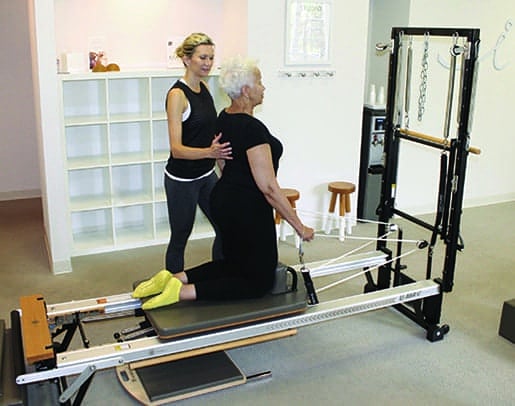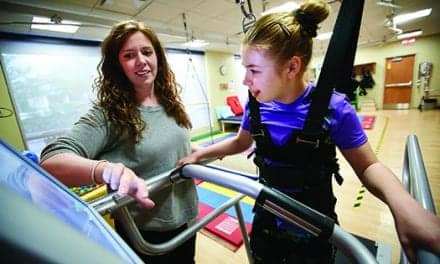
Pilates equipment can position for and facilitate desired movement and targeted musculature. Contemporary therapeutic Pilates approaches teach the concept of neutral spine alignment.
by Sara Baker, PT, MS, OCS Age-related hyperkyphosis affects up to 40% of adults over age 60. Characterized by a Cobb angle of kyphosis greater than 40°, this excessive forward curvature of the thoracic spine limits mobility, impacts self-image, and leads to a host of related health issues. Once kyphosis progresses past 50°, mechanical restrictions can impair respiratory function, leading to pneumonia and chronic obstructive pulmonary disease (COPD). There is an increased risk of falls and fractures due to balance impairment, as well as difficulty with daily activities, social limitations, lower life satisfaction, and earlier mortality.1 Hyperkyphosis takes an emotional toll as well: The discomfort and appearance of the curvature can result in poor self-image and lower self-confidence, which may lead to withdrawal from social activities, isolation, and depression. These co-morbidities and social side effects drive up healthcare costs, and decrease quality of life and longevity. Hyperkyphosis has only been recognized as a significant health concern relatively recently, and a standard of care has yet to be established. As our population ages, and the issue becomes increasingly prevalent, it’s vital to find evidence-based treatments to address this debilitating condition. Typically, hyperkyphosis is treated with modalities including surgery, bracing, and physical therapy, but other modalities, including exercise and postural education, are emerging as effective treatments as well.
Improving Cobb Angle of Kyphosis with Exercise
The idea that we can actually improve the Cobb angle of someone with hyperkyphosis using an exercise-focused treatment is an exciting one for therapists and clients alike. A promising new study by Katzman et al.2 shows that targeted spine-strengthening exercises and posture training are effective rehabilitation modalities for decreasing hyperkyphosis in older adults. The study cites spinal extensor strengthening, spinal mobility exercises, and other posture-focused exercises as successful in reducing both radiographic and clinical measures of hyperkyphosis by up to 4°. While a number of studies have been conducted into exercise and hyperkyphosis treatment,3 this is the first randomized controlled trial demonstrating the effectiveness of specific types of exercises on reducing hyperkyphosis. The results should garner the attention of the physical therapy community as an evidence-based intervention. The active group in the study received exercise training that focused on proper recruitment of spinal extensors, with an emphasis on quality of movement. Postural training was implemented with auditory, visual, and tactile input and feedback, with specific training on neutral spine concepts. Training was administered in a small group setting with a 1:5 ratio of skilled instructor to participants. Therapists looking to use this study to direct their intervention would do well to use a movement system that incorporates these important elements; the study includes intervention details for therapists looking to put the information into practice.
An Accessible Therapeutic Framework
Therapeutic Pilates is one system therapists can use to achieve the kinds of results outlined in the study. Like the exercises outlined by the researchers, it uses exercises and equipment that strengthen spinal extensors and improve spinal mobility. The Pilates teaching method uses tactile, auditory, and visual cues to help participants achieve proper recruitment of targeted musculature and postural alignment. The emphasis while performing exercises is on quality of movement, body awareness, and a progression toward automaticity in proper muscular recruitment and posture. Pilates equipment can position for and facilitate desired movement and targeted musculature. Contemporary therapeutic Pilates approaches teach the concept of neutral spinal alignment. It can regress or progress exercises to maintain neutral spinal posture, irrespective of positioning in relation to gravity, application of load, or direction of load, achieving the ability to improve and maintain optimal spinal alignment in a variety of functional positions and movements.
Helping Patients Understand Their Bodies Better
A therapeutic Pilates-based intervention gives therapists a systematic approach to educating clients about areas of their body such as their scapula, rib cage, and pelvis, through exercises that bring awareness to these regions. The therapist can then build an understanding of the cumulative alignment of the head in relation to the rib cage and pelvis, and how these relationships make up posture. This postural understanding becomes ingrained in their kinesthetic sense and is a tool they can use in everyday life. Pilates also introduces specialized equipment and props to enable movement and give proprioceptive input. Working spinal extensors in a prone position can be uncomfortable for a client with hyperkyphosis and challenging for a therapist looking to facilitate proper muscular recruitment and mechanics. Props such as the arc barrel and stability barrel allow the client to start in their neutral (a hyperkyphotic position) and move into extension to find a more neutral (less kyphotic) position. From there, you can build strength and endurance in the spinal extensors. Using props is encouraging for clients—it can be incredibly freeing for them to move through exercises with fewer encumbrances.
Pilates-Based Intervention in Practice
The goals of this therapeutic exercise and neuromuscular re-education are to: • Strengthen spinal extensors and integrate into posterior slings/chains of the body • Improve spinal mobility and stability • Improve postural awareness and control in a variety of positions, with gravity acting on the body in varying planes, with and without load The following is a three-step progression of exercises* demonstrating how Pilates exercises develop a foundation of control, mobility, and awareness, then build on that by varying position, load (gravity/body weight or spring resistance) and choreography to increase challenge and progress exercises. *This programming is for clients with hyperkyphosis in the absence of osteopenia or osteoporosis.
PHASE I
• Breathing with resistance band around lower rib cage to facilitate 3D breath pattern and diaphragmatic breath, discuss breath mechanics and need for rib cage excursion in posterolateral direction. Beginning facilitation of rib cage and spinal mobility. Relate inhale to spinal extension and exhale to spinal flexion. • Scapula isolations seated with foam roller along spine (pro-retraction, elevation, depression) educate on positioning of scapula in neutral, mobility of scapula for healthy spinal and shoulder mechanics. Relate coupled movements of scapular retraction/spinal extension, scapular protraction/spinal flexion. • Supine head positioning with pads to achieve neutral cervical spine, positioning of rib cage and pelvic neutral. Use peripheral movement such as arm scissors and circles to challenge holding this neutral spinal alignment. Illustrate the abdominal musculature origin and insertions as the connection which relate the rib cage to the pelvis. Often with a hyperkyphotic posture there will be a thoracolumbar region hypermobility. • Bilateral closed-chain hip extension prone over arc barrel or BOSU with head down resting on backs of hands. Monitor cervical and thoracolumbar region as client extends hip and lifts knee off mat. Teaching spinal stability with proper hip extension recruitment pattern. Progress to single leg and then to open chain. • Log roll with foam roller, sidelying. Cue the relationship and stability of head, rib cage, and pelvis with a 45-degree forward roll and return to sidelying. Facilitates multifidus.
PHASE II
• Breathing sidelying over arc barrel or BOSU • Arm work on Long Box-scapula isolations • Spine stretch forward with tactile cueing of segmental stacking of spine with spinal extension • Cat stretch • Spinal rotation • Breast stroke prep II over stability barrel, arc barrel, or BOSU • Standing thigh stretch on reformer • Swimming prep over arc barrel or BOSU
PHASE III
• Mermaid on Reformer • Arms pulling straps – plow, tricep • Chest expansion • Front rowing prep – straight forward and offering • Back rowing prep – mid-trap strengthener and plow • Breast stroke prep I and III • Swimming prep quadruped on rotational discs • Side twist seated on reformer • Knee stretches prep – flat back

Once introduced to the Pilates modality, it is a natural progression for the client to continue with classes, private instruction, or individual practice, especially when it is so widely available.
A Path to Long-Term Wellness
There are two things we should always be asking ourselves. One, “When my client is discharged from therapy, what are the chances they’ll continue with the exercises I’ve given them?” and two, “Am I propelling them forward toward a healthier, more active lifestyle?” It is critical for clients managing hyperkyphosis to continue with a targeted strengthening and posture-focused fitness program. A Pilates-based therapeutic intervention introduces a method of movement that can be seamlessly continued into a maintenance and fitness program post-rehab. The postural education and understanding of how body positioning impacts health can make clients understand why they’re doing certain exercises, which increases their compliance. That knowledge empowers them to problem-solve when the therapist is not there, and it gives clients a higher level of education and awareness they can then carry on through the rest of their life. The likelihood is much higher that the gains clients make in therapy will be maintained. The benefit to Pilates specifically is its ubiquity—classes are generally easy to find, no matter where the client is located. Plus, there is considerable growth in specialty training programs both domestically and internationally—especially within the areas of rehabilitative conditioning practitioners, senior population specialists, and instructors seeking skills to assist professional athletes and special populations. Once introduced to the modality, it is a natural progression for the client to continue with classes, private instruction, or individual practice, especially when it is so widely available. It makes the transition to post-rehab easier, continues to benefit their hyperkyphosis, and provides an opportunity for fitness that they might not otherwise consider. By taking that initial exposure and continuing it into a fitness program, clients are elevating their overall wellness, from rehab all the way through to fitness and maintenance. In addition, classes are a positive social outlet for older adults who may otherwise be isolated, which can be beneficial to their mental health and enhance their overall quality of life.
Evidence-Based Treatment Empowers Your Patients
The types of exercise interventions mentioned in the study1 have been proven to strengthen spinal extensors and improve posture in patients with hyperkyphosis. It’s exciting evidence that we can successfully change the bleak prognosis many sufferers face—and help people improve their posture while staying fitter and healthier over the course of their lives. RM Sara Baker, PT, MS, OCS, is president of Inspire Health, an organization providing physical therapy, Pilates, and wellness services with two locations in the Atlanta area. Baker received a bachelor of science in cellular biology from the University of Georgia, and a master of science in physical therapy from the University of Alabama at Birmingham. She specializes in spinal conditions and neuromuscular re-education. Inspire Health is a Merrithew Licensed Training Center, and Baker is a STOTT PILATES Rehab Instructor Trainer. For more information, contact [email protected].
References
1. Roghani T, Zavieh MK, Manshadi FD, King N, Katzman W. Age related hyperkyphosis: update of its potential causes and clinical impacts – narrative review. Aging Cin Exp Res. 2017;29(4):567-577. 2. Katzman WB, Vittinghoff E, Lin F, et al. Targeted spine-strengthening exercises and posture training program to reduce hyperkyphosis in older adults: results from the study of hyperkyphosis, exercise and function (SHEAF) randomized controlled trial. Osteoporo Intl. 2017;28(1):2831-2841. 3. Bansal S, Katzman W, Giangregorio, L. Exercise for improving age-related hyperkyphotic posture: a systematic review. Arch Phys Med Rehabil. 2014;95(1):129-140.





I am interested in knowing more about the exercises. Can anyone guide?
Hi Sunil, check the recent post on Merrithew blog https://www.merrithew.com/blog/post/2018-10-23/new-post-rehab-programming